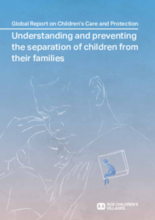In this report, SOS Children's Villages and partners from 10 academic institutions from around the world, have researched the phenomenon of child-family separation and what can be done to prevent it. This research tries to fill a global gap of information regarding middle and low-income countries, the contexts of which are not well understood.
The research adopts a child-centred approach to value the lived experiences and voices of the children and families impacted by separation that are largely missing in current studies.
The Research Explores:
-
The drivers of child-family separation
-
The situation of children affected by it
-
Gaps in multi-sectoral and multi-level responses to prevent and address child-family separation
Research Components:
The research components include:
8 country case studies, in high, low and middle-income contexts: Denmark, El Salvador, Indonesia, Ivory Coast, Kenya, Kyrgyzstan, Lebanon, and Uruguay. This involved participatory research with children, young people, family members and consultations with stakeholders from multiple sectors, including child protection and social protection (Child Consulting Ltd and local partner universities)
Complementary follow-on research including:
-
A global desk review and four country case studies in El Salvador, Denmark, Kenya and Lebanon on decision-making of the social workforce in state gatekeeping systems (Child Consulting Ltd and local partner universities)
-
Rapid evidence reviews looking at further aspects of the research questions
Conceptual Framework and Methodology:
Our conceptual framework takes a holistic approach to understanding and assessing the drivers of child-family separation. Grounded in a socio-ecological model, we gauge the perspectives of multiple actors including children, young people, family members and professionals, and analyze how these relate to contexts around them.
The research employs a mixed-methods methodology, combining the analysis of existing research and data, as well as the collection of new qualitative data. This helps us understand the current state of knowledge on the topic and builds on that with the perspectives and experiences of children, young people, family members and professionals and their proposed strategies for change.

